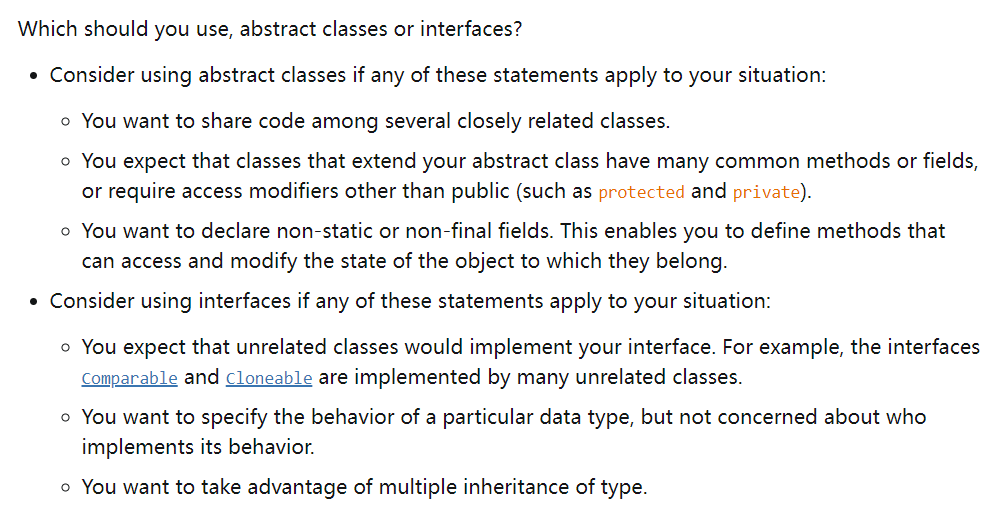继承
Java只有单继承,最顶级的父类是Object。
子类会继承父类的fields和methods,而不会继承constructors,因为constructors不属于methods,但是子类可以通过super调用父类的constructor。
子类继承父类的范围是:public、protected、package-private
隐式转换,子类转父类(只有1个爸爸):
Object obj = new MountainBike();显示转换,父类转子类(有多个子女,所以要明确指定):
MountainBike myBike = (MountainBike)obj;类有field,而接口没有,所以在多继承时就有问题:如果多个类有相同的field,那么子类将不知道用哪一个,而接口不存在这个问题。Java不支持继承多个类,但是可以实现多个接口。
重载
子类的方法跟父类有完全相同的签名和返回类型(也可以是子类),将会覆盖父类方法Override。
如果子类定义了1个static方法,跟父类完全相同,那么父类方法会被隐藏Hide。
Override和Hide是不同的:
public class Animal {
public static void testClassMethod() {
System.out.println("The static method in Animal");
}
public void testInstanceMethod() {
System.out.println("The instance method in Animal");
}
}public class Cat extends Animal {
public static void testClassMethod() {
System.out.println("The static method in Cat");
}
public void testInstanceMethod() {
System.out.println("The instance method in Cat");
}
public static void main(String[] args) {
Cat myCat = new Cat();
Animal myAnimal = myCat; // 隐式转换
Animal.testClassMethod(); // 调的父类
myAnimal.testInstanceMethod(); // 父类对象引用,还是调的子类
}
}The static method in Animal
The instance method in CatOverride只会调子类方法,而Hide取决于调用方是父还是子,比如这里的myCat,隐式转换为父类Animal后,会调父类的static方法,而调的实例方法却是子类的。(如果不是隐式转换,而是直接给父类实例化,那肯定还是调父类方法)
类instance方法优先于接口default方法:
public class Horse {
public String identifyMyself() {
return "I am a horse.";
}
}
public interface Flyer {
default public String identifyMyself() {
return "I am able to fly.";
}
}
public interface Mythical {
default public String identifyMyself() {
return "I am a mythical creature.";
}
}
public class Pegasus extends Horse implements Flyer, Mythical {
public static void main(String... args) {
Pegasus myApp = new Pegasus();
System.out.println(myApp.identifyMyself());
}
}输出为I am a horse.
Override的优先:
public interface Animal {
default public String identifyMyself() {
return "I am an animal.";
}
}
public interface EggLayer extends Animal {
default public String identifyMyself() {
return "I am able to lay eggs.";
}
}
public interface FireBreather extends Animal { }
public class Dragon implements EggLayer, FireBreather {
public static void main (String... args) {
Dragon myApp = new Dragon();
System.out.println(myApp.identifyMyself());
}
}输出为I am able to lay eggs
如果实现多接口,有同名的,需要显示指定调用方:
public interface OperateCar {
// ...
default public int startEngine(EncryptedKey key) {
// Implementation
}
}
public interface FlyCar {
// ...
default public int startEngine(EncryptedKey key) {
// Implementation
}
}public class FlyingCar implements OperateCar, FlyCar {
// ...
public int startEngine(EncryptedKey key) {
FlyCar.super.startEngine(key); // 显示指定,并且使用super
OperateCar.super.startEngine(key);
}
}总结下,如果子类方法签名+return跟父类方法一样,有以下4种情况:

注意compile-time error,static方法不能和instance方法一样,因为它们是不同级别的。
多态
MountainBike和RoadBike都继承Bicycle,虽然都有printDescription,但它们有多样的形态:
public class MountainBike extends Bicycle {
private String suspension;
public MountainBike(
int startCadence,
int startSpeed,
int startGear,
String suspensionType){
super(startCadence,
startSpeed,
startGear);
this.setSuspension(suspensionType);
}
public String getSuspension(){
return this.suspension;
}
public void setSuspension(String suspensionType) {
this.suspension = suspensionType;
}
public void printDescription() {
super.printDescription();
System.out.println("The " + "MountainBike has a" +
getSuspension() + " suspension.");
}
}public class RoadBike extends Bicycle{
// In millimeters (mm)
private int tireWidth;
public RoadBike(int startCadence,
int startSpeed,
int startGear,
int newTireWidth){
super(startCadence,
startSpeed,
startGear);
this.setTireWidth(newTireWidth);
}
public int getTireWidth(){
return this.tireWidth;
}
public void setTireWidth(int newTireWidth){
this.tireWidth = newTireWidth;
}
public void printDescription(){
super.printDescription();
System.out.println("The RoadBike" + " has " + getTireWidth() +
" MM tires.");
}
}所谓的虚拟方法调用,名字很高大上,其实质就是,子类重载了父类方法,在调用子类实例方法时,先调子类实现:

注意,子类的field如果和父类的一样,那么父类的field会被hide,即使type不一样。如果要使用父类的field,需要关键字super。同名fileld是不好的设计,应该尽量避免。
super关键字
public class Superclass {
public void printMethod() {
System.out.println("Printed in Superclass.");
}
}public class Subclass extends Superclass {
// overrides printMethod in Superclass
public void printMethod() {
super.printMethod();
System.out.println("Printed in Subclass");
}
public static void main(String[] args) {
Subclass s = new Subclass();
s.printMethod();
}
}在子类constructor中,如果没有显式super,那么会调用默认的super()
Object
Java中的所有类,都终极继承了Object。(继承链的顶端)
toString()
System.out.println(firstBook.toString());equals()
public class Book {
String ISBN;
public String getISBN() {
return ISBN;
}
public boolean equals(Object obj) {
if (obj instanceof Book)
return ISBN.equals((Book)obj.getISBN());
else
return false;
}
}hashCode()
如果两个对象相等,那么它们的hashCode一定相等。重写equals(),必须重写hashCode()
getClass()
void printClassName(Object obj) {
System.out.println("The object's" + " class is " +
obj.getClass().getSimpleName());
}clone()
aCloneableObject.clone();finalize()
垃圾回收时调用。它的调用时机是不确定的,不要使用它来做逻辑。
抽象
abstract class,抽象类,不能被实例化,但是可以继承。
abstract void moveTo(double deltaX, double deltaY);如果抽象类有method,那么也必须是abstract:
public abstract class GraphicObject {
// declare fields
// declare nonabstract methods
abstract void draw();
}子类必须抽象类的所有方法,否则子类也必须是abstract。
抽象类:(not static、final) field,(public、protected、private) method
接口:public static final field,public method
Java中,抽象类的例子是AbstractMap、接口的例子是HashMap实现的Serializable, Cloneable, and Map<K, V>接口。

如果类没有实现接口中的所有方法,可以定义为abstract,然后由子类来实现剩余的全部方法:
abstract class X implements Y {
// implements all but one method of Y
}
class XX extends X {
// implements the remaining method in Y
}X没有实现全部方法,所以是abstract,子类XX实现剩余全部方法。
参考资料:
Inheritance https://dev.java/learn/inheritance/